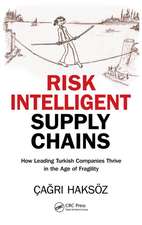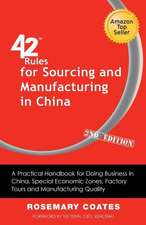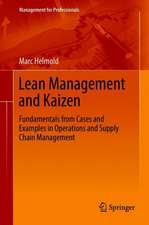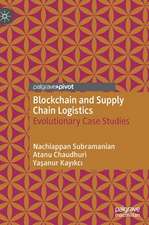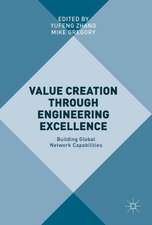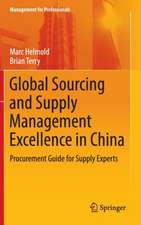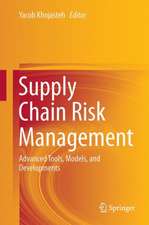Supply Chain Integration Challenges in Commercial Aerospace: A Comprehensive Perspective on the Aviation Value Chain
Editat de Klaus Richter, Johannes Waltheren Limba Engleză Paperback – 13 iul 2018
Accordingly, the chapters address the challenges of configuration and demand, and highlight the specificities of customization in the aviation industry. They analyze component manufacturing, share valuable insights into assembly and integration activities, and describe aftermarket business models.
In order to ensure more varied and balanced coverage, the book includes contributions by researchers, suppliers, and experts and practitioners from consulting companies and the aircraft industry. Taken together, they provide a holistic perspective on the transformation drivers and the innovations that have either been implemented or will be adopted in the near future.
The book introduces and describes new concepts and innovations such as 3D printing, E2E demand management, digital production, predictive maintenance and open innovation in general, supplementing them with sample industrial applications from the aviation sector.
| Toate formatele și edițiile | Preț | Express |
|---|---|---|
| Paperback (1) | 454.92 lei 6-8 săpt. | |
| Springer International Publishing – 13 iul 2018 | 454.92 lei 6-8 săpt. | |
| Hardback (1) | 590.63 lei 6-8 săpt. | |
| Springer International Publishing – 21 dec 2016 | 590.63 lei 6-8 săpt. |
Preț: 454.92 lei
Nou
Puncte Express: 682
Preț estimativ în valută:
87.05€ • 90.67$ • 72.57£
87.05€ • 90.67$ • 72.57£
Carte tipărită la comandă
Livrare economică 28 martie-11 aprilie
Preluare comenzi: 021 569.72.76
Specificații
ISBN-13: 9783319834542
ISBN-10: 3319834541
Ilustrații: VI, 297 p. 120 illus.
Dimensiuni: 155 x 235 mm
Greutate: 0.43 kg
Ediția:Softcover reprint of the original 1st ed. 2017
Editura: Springer International Publishing
Colecția Springer
Locul publicării:Cham, Switzerland
ISBN-10: 3319834541
Ilustrații: VI, 297 p. 120 illus.
Dimensiuni: 155 x 235 mm
Greutate: 0.43 kg
Ediția:Softcover reprint of the original 1st ed. 2017
Editura: Springer International Publishing
Colecția Springer
Locul publicării:Cham, Switzerland
Cuprins
Introduction.- Part I: Product Development.- Part II: Configuration and Demand.- Part III: Component Manufacturing.- Part IV: Assembly and Integration.- Part V: Life Cycle Business Models and Aftermarkets.- Outlook.
Notă biografică
Professor Dr. Johannes Walther is Head of the Institute for Production Management (IPM) and professor of Business Administration with a focus on production management at the Faculty of Economics at Ostfalia University of Applied Sciences. He is the publisher of "Supply Chain Management"(TM) magazine, member of the advisory board of the Volkswagen Group Institute for Procurement (IFB) and the Academic Forum of Volkswagen Group Procurement, as well as lecturer at the Volkswagen Group AutoUni. He studied economics at the University of Hannover. After earning his doctorate degree in 1992 he assumed leading positions in industry, trade and service companies. Born in Hannover in 1959, Johannes is married with two children and currently lives in Hannover, Germany.
Klaus Richter is Chief Procurement Officer for Airbus Group & Airbus. Additionally he serves as Chairman of the Board of Airbus Germany and leads the supervisory board of Premium AEROTEC Group. Klaus' professional path within Airbus Group dates back to 2007 when he joined Airbus S.A.S. as Executive Vice President Procurement. Before joining Airbus Group Klaus was Senior Vice President Materials Purchasing for BMW. He started his career with McKinsey & Company where he worked as management consultant for automotive, electronics and aerospace businesses and product development. He graduated from Technical University of Munich, Germany, with a PhD in Mechanical Engineering and spent two years as a researcher and lecturer at the University of California at Berkeley. Born in Munich in 1964, Klaus is married with two children and currently lives in Toulouse, France.
Textul de pe ultima copertă
This book presents firsthand insights into strategies and approaches for the commercial aerospace supply chain in response to the numerous changes that airlines, aircraft OEMs and their suppliers have experienced over the past few decades. In doing so, it investigates the entire product value chain.
Accordingly, the chapters address the challenges of configuration and demand, and highlight the specificities of customization in the aviation industry. They analyze component manufacturing, share valuable insights into assembly and integration activities, and describe aftermarket business models.
In order to ensure more varied and balanced coverage, the book includes contributions by researchers, suppliers, and experts and practitioners from consulting companies and the aircraft industry. Taken together, they provide a holistic perspective on the transformation drivers and the innovations that have either been implemented or will be adopted in the near future.
Thebook introduces and describes new concepts and innovations such as 3D printing, E2E demand management, digital production, predictive maintenance and open innovation in general, supplementing them with sample industrial applications from the aviation sector.
Accordingly, the chapters address the challenges of configuration and demand, and highlight the specificities of customization in the aviation industry. They analyze component manufacturing, share valuable insights into assembly and integration activities, and describe aftermarket business models.
In order to ensure more varied and balanced coverage, the book includes contributions by researchers, suppliers, and experts and practitioners from consulting companies and the aircraft industry. Taken together, they provide a holistic perspective on the transformation drivers and the innovations that have either been implemented or will be adopted in the near future.
Thebook introduces and describes new concepts and innovations such as 3D printing, E2E demand management, digital production, predictive maintenance and open innovation in general, supplementing them with sample industrial applications from the aviation sector.
Caracteristici
Introduces innovative concepts and future trends for the aviation supply chain Provides perspectives from a broad range of participants in the value chain Integrates academic insights and best practice experience



